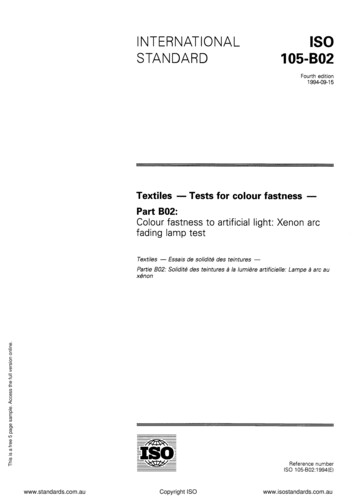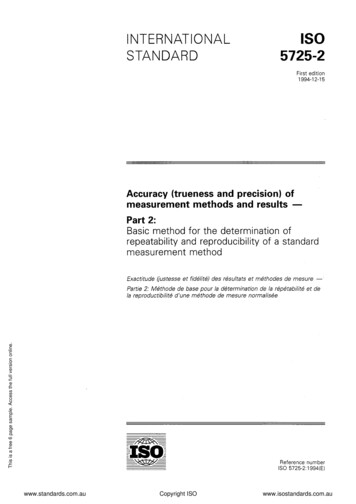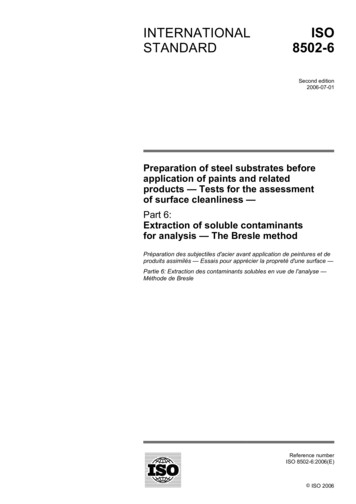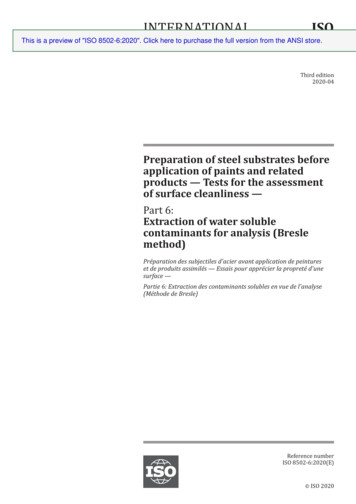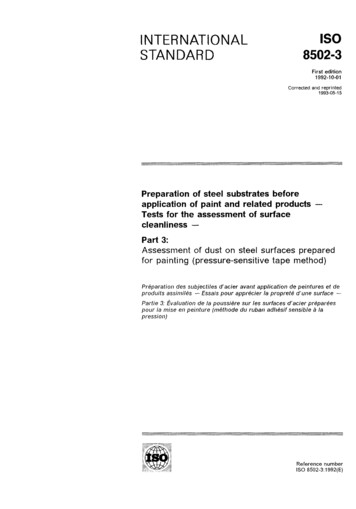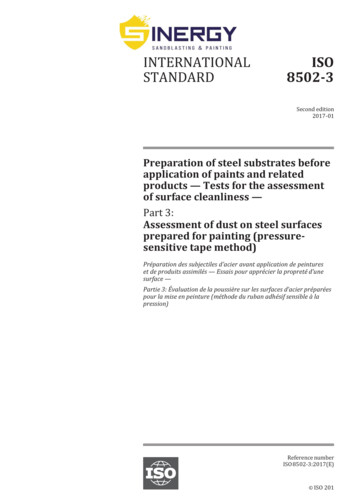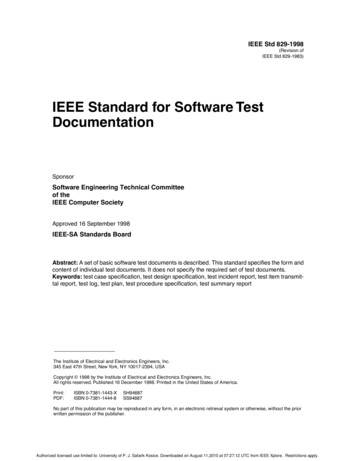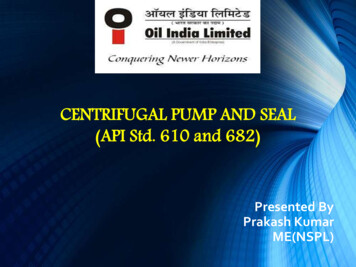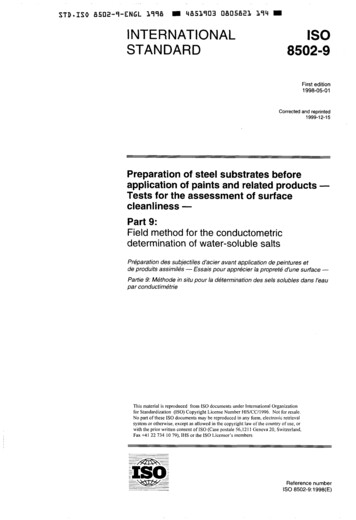
Transcription
STD-IS0 8502-9-ENGL1998 I4851903 0805821 194 WINTERNATIONALSTANDARDIS08502-9First edition1998-05-01Corrected and reprinted1999-12-15Preparation of steel substrates beforeapplication of paints and related products Tests for the assessment of surfacecleanliness Part 9:Field method for the conductometricdetermination of water-soluble saltsPréparation des subjectiles d’acier avant application de peintures etde produits assimilés - Essais pour apprécier la propreté d‘une surface Partie 9: Méthode in situ pour la détermination des sels solubles dans l’eaupar conductimétrieThis material is reproduced from IS0 documents under International Organizationfor Standardization (ISO) Copyright License Number HIS/CC/I 996. Not for resale.No part oftliese IS0 documents may be reprodiiced in any form, electronic retrievalsystem or otherwise, except as allowed in the copyright law ofthe country of lise, orwith the prior written consent of IS0 (Case poslale 56,121 I Geneva 20, Switzerland,Fax 41 22 734 10 79), IHS or the I S 0 Licensor’s members.Reference numberIS0 8502-9:1998(E)
STDOIS0 8502-9-ENGL39984853903 0805822 020IS0 8502-9: 1998(E)ForewordIS0 (the International Organization for Standardization) is a worldwide federation of nationalstandards bodies (IS0 member bodies). The work of preparing International Standards isnormally carried out through IS0 technical committees. Each member body interested in asubject for which a technical committee has been established has the right to be representedon that committee. International organizations, governmental and non-governmental, inliaison with ISO, also take part in the work. IS0 collaborates closely with the InternationalElectrotechnical Commission (IEC) on all matters of electrotechnical standardization.Draft International Standards adopted by the technical committees are circulated to themember bodies for voting. Publication as an International Standard requires approval by atleast 75 % of the member bodies casting a vote.Intemational Standard IS0 8502-9 was prepared by Technical Committee ISO/TC 35, Paintsand varnishes, Subcommittee SC 12, Preparation of steel substrates before application ofpaints and related products.IS0 8502 consists of the following parts, under the general title Preparation of steelsubstrates before application of paints and related products - Tests for the assessment ofsurface cleanliness:- Part I : Field test for soluble iron corrosion products[Technical Report]- Part 2: Laboratory determination of chloride on cleaned surfaces- Part 3: Assessment of dust on steel sugaces prepared for painting (pressure-sensitivetape method)- Part 4: Guidance on the estimation of the probability of condensation prior to paintapplicationQ IS01998All rights reserved. UnleSS otherwise specified, no part of this publication may be reproducedor utilized in any form or by any means, electronic or mechanical, including photocopyingandmicrofilm,without permission in wrifng from the publisher.Intemational Organizationfor StandardizationCase postale 56 CH-1211 Genève 20 SwitzerlandIntemet central8 iso.chX.400c ch; a3400net; p iso; o isocs; s centralPrinted in Switzerland
STD-IS0 8502-9-ENGL I998 H 4853903 0805823 Tb7 9o IS0I S 0 8502-9:1998(E)- Part 5: Measurement of chloride on steel sutj5aces prepared for painting - Ion detectiontube method-Part 6: Extraction of soluble contaminants for analysis - The Bresle method- Part 7: Field method for determination of oil and grease-Part 8: Field method for refractometric determination of moisture- Part 9: Field method for the conductometric determination of water-soluble salts- Part 10: Field method for the titrimetric determination of chloride.II1
- STD*ISO 8502-9-ENGL L998 H 4853903 0805824 9T3 HI S 0 8502-9:1998(E)IntroductionThe performance of protective coatings of paint and related products applied to steel issignificantly affected by the state of the steel surface immediately prior to painting. Theprincipal factors that are known to influence this performance are:a) the presence of rust and mill scale;b) the presence of surface contaminants, including salts, dust, oils and greases;c) the surface profile.International Standards IS0 8501, IS0 8502 and IS0 8503 have been prepared to providemethods of assessing these factors, while IS0 8504 provides guidance on the preparationmethods that are available for cleaning steel substrates, indicating the capabilities of each inattaining specified levels of cleanliness.These International Standards do not contain recommendations for the protective coating systemto be applied to the steel surface. Neither do they contain recornendations for the surfacequality requirements for specific situations even though surface quality can have a directinfluence on the choice of protective coating to be applied and on its performance. Suchrecommendations are found in other documents such as national standards and codes ofpractice. It will be necessary for the users of these International Standards to ensure that thequalities specified are:-compatible and appropriate both for the environmental conditions to which the steelwill be exposed and for the protective coating system to be used;-within the capability of the cleaning procedure specified.The four Intemational Standards referred to above deal with the following aspects of preparationof steel substrates:IS0 8501Visual assessment of surface cleanliness;IS0 8502Testsfor the assessment of sulface cleanliness;IS0 8503Suflace roughness characteristics of blast-cleaned steel substrates;IS0 8504Surface preparation methods.Each of these International Standards is in turn divided into separate parts.ivQIS0
STD ISO 4502-7-ENGL17784853703 0805425 43TI S 0 8502-9: 1998(E)This part of IS0 8502 describes a field method for the assessment of the total amount of watersoluble salts, the salts being regarded as forming one single contaminant. The more aggressivecontaminants causing corrosion and blistering (the ionic species) can easily be dissolved off anddetermined rapidly by this method. Consequently, the less aggressive and not so easily dissolvedminor part of contaminant will remain un-assessed. For additional information on the testmethod, its potential and its limitations, see BRESLE, Å., Conductometric determination ofsalts on steel surfaces, MP (Materials Perf¿mzance),June 1995, Vol. 34, No. 6, pp. 35-37,NACE International, Houston TX, USA.Rusty steel substrates, particularly those of rust grades C or D (see IS0 8501-i), even whenblast-cleaned to preparation grade S a 3 (see ISO8501-1 and ISO8501-2), may still becontaminated by water-soluble salts and corrosion products. These compounds are almostcolourless and are localized at the lowest point of the rust pits. If they are not removed prior topainting, chemical reactions can result in blister formation and accumulations of rust thatdestroy the adhesion between the substrate and the applied protective coating.V
STD.IS0 6502-9-ENCLINTERNATIONAL STANDARD019984853903 080582b 776 WIS0I S 0 8502-9:1998(E)Preparation of steel substrates before application of paintsand related products -Tests for the assessment of surfacecleanliness Part 9:Field method for the conductometric determination of water-solublesalts1 ScopeThis part of IS0 8502 describes a field method for the assessment of the total surface density ofvarious water-soluble salts (mostly chlorides and sulfates) on steel surfaces before and/or aftersurface preparation.The individual surface densities of chlorides, sulfates, etc., cannot be determined by thismethod.This method assesses ionic contaminants only. These represent the greater part of thecontamination.2 Normative referencesThe following standards contain provisions which, through reference in this text, constituteprovisions of this part of IS0 8502. At the time of publication, the editions indicated were valid.All standards are subject to revision, and parties to agreement based on this part of IS0 8502 areencouraged to investigate the possibility of applying the most recent editions of the standardsindicated below. Members of IEC and I S 0 maintain registers of currently valid InternationalStandards.IS0 3696: 1987, Waterfor analytical laboratory use - Specification and test methods.IS0 8502-6:1995, Preparation of steel substrates before application of paints and relatedproducts - Tests for the assessment of su ace cleanliness - Part 6: Extraction of solublecontaminants for analysis - The Bresle method.3 PrincipleThe salts on the given area of the steel surface are dissolved by the Bresle method (seeIS0 8502-6), using water as solvent. The conductivity of the solution thus obtained is measured.Finally, the total surface density of the salts in this area is calculated by a simple but sufficientlyaccurate equation.1
vSTD*ISO 8502-9-ENGL19984851903 0805827 ho2 WIS0 8502-9: 1998(E)4 SolventWater of at least grade 3 purity in accordance with IS0 3696.NOTE - Usually, distilled or de-ionized water of conductivity less than 0,5 mS/m (5 @km) meetsthis requirement.5 Apparatus and materials5.1 Conductometer, with temperature compensation and sufficient range, e.g. from O mS/m(O pS/cm) to 200 mS/m (2000 pS/cm).5.2 Glass beaker, of convenient size and shape for housing the electrode end of theconductometer (5.1) during measurement.5.3 Standard adhesive patch, as specified in 4.1 of IS0 8502-6: 1995, e.g. of size A-1250.NOTEThe patch should not cause any noticable contamination of the extraction liquid. Certainpatches are available today which are guaranteed to cause an ionic contamination of less than 7 mg/m2,which is generally satisfactory. If there is no guarantee or if improved accuracy is required, then a blanktest is recommended.5.4 Syringe, as specified in 4.2 of IS0 8502-61995.6 Procedure6.1 Preparation of water and blank test6.1.1 Pour into the beaker (5.2) an amount of water (clause 4) that is just large enough for theoperation of the conductometer (5.1). Usually a volume between 10 ml and 20 ml is needed. Toprevent foreign matter inside the beaker and syringe, and on the conductometer probe, frominfluencing the result, carry out the following blank test.6.1.2 Completely fill the syringe (5.4) with water from the beaker. Then empty the syringe backinto the beaker.6.1.3 Immerse the electrodes of the conductometer fully in the water in the beaker and agitategently. Record the conductivity (yi) and the units in which it is expressed, for example pS/cm.6.2 Removal of salts from the steel surface6.2.1 Follow the procedure specified in clause 5 of IS0 8502-6:1995, subject to the followingspecific requirements.63.2 Fill the syringe with about one-quarter of the water contained in the beaker.6.2.3 After 1 min, suck the water back into the syringe cylinder (see 5.6 of I S 0 8502-6:1995).2QIS0
STD-IS0 8502-9-ENGL19984853903 0805828 549IS0 8502-9:1998(E)6.2.4 Without removing the syringe needle from the patch, re-inject the water into the patchcompartment and then suck the water back into the syringe cylinder. Repeat until 10 cycles ofinjection and sucking have been completed (see 5.7 of I S 0 8502-6:1995).6.2.5 At the end of the 10th cycle, retrieve as much as possible of the water from the patchcompartment and transfer to the beaker (5.2), thus restoring its content to nearly the originalvolume in 6.1.1 (see 5.8 of 8502-6:1995).6.3 Conductometric measurementImmerse the electrodes of the conductometer fully in the now contaminated water in the beaker,and record the conductivity (y2)expressed in the same units as in 6.1.3.7 Expression of resultsThe total surface density pA of the salts is given by the equationPA m2.( 1)wherernis the mass of salts dissolved from that part of the surface which is covered by thepatch compartment;Ais the area of that part of the surface.In this case, rn is given bym c . V . Ay.(2)wherecis an empirical constant approximately equal to 5 kg.m-2.S- 1 (see also clause 8);Vis the original volume of water in the beaker (see 6.1. i);Ay is the change in conductivity, i.e. the difference between the conductivity measuredin 6.3 (y2) and the conductivity measured in 6.1.3 (y,).From ( i ) and (2),it follows that- c . V . AyPA ASince c 5 kg.m-2 .S-1 , and if for example V 10 ml (6.1.1) andA 1250 mm2 (5.3), it followsthatPA Ay.40.kg.m-'.S-'.(4)3
Equation (4) gives pAexpressed in the SI unit kg/m2.Multiplying the numerical value obtained from equation (4) by lo6gives pAin mg/m2.Multiplying the numerical value obtained from equation (4)by lo5gives pAin pg/cm2.Inserting different values of V in equation (3) for other volumes of water gives equations similarto equation (4). Three straight lines corresponding to three different equations are plotted infigure 1.fmInuO).cY,L 1UO00L Indm4Ot500O50100150200Change in conductivity, A a lpS/crn)NOTE-Each straight line corresponds to a different volume of water in the beaker. In each case,the patch size is A-1250, in accordance with IS0 8502-6.Figure 1 -The total surface density pAof the salts as a function of the changein conductivity A y4
-STDeISO 6502-9-ENGL k978485l903 0805830 lT7mI S 0 8502-9:1998(E)8 AccuracyThe accuracy of the method depends on the accuracy of the empirical constant c in equation (3),and on the accuracy to which the variables in that equation can be determined. But other factorswill also have an influence on the accuracy, such as variations in temperature. Very little hasbeen published on these matters. Practical experience has shown, however, that most variationshave negligible influence on the overall accuracy, except that in the constant c, which isdependent upon the types of salt dissolved in the water in 6.2.In the majority of cases, the following types of ion are pre-dominant in the water: Cl-, S04",HC03-, Na', Ca" and Fe". Other types of ion may also be present. Usually, however, theircontribution to the variation in the constant c is only marginal.The value of the constant c (5 kg.m
IS0 8502-6: 1995, Preparation of steel substrates before application of paints and related products - Tests for the assessment of su ace cleanliness - Part 6: Extraction of soluble contaminants for analysis - File Size: 435KBPage Count: 11



